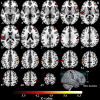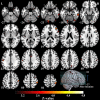Comparison of brain functional response to mechanical prickling stimuli to the glabrous and hairy skin
- PMID: 37753684
- PMCID: PMC10460934
- DOI: 10.1111/srt.13446
Comparison of brain functional response to mechanical prickling stimuli to the glabrous and hairy skin
Abstract
Background: A kind of prickle sensation, which is a composite feeling of pain and itch, can be evoked by mechanical stimulation of fiber ends from fabric surface against to human hairy skin, rather than glabrous skin. Now, a functional magnetic resonance imaging (fMRI) study was conducted to investigate the cognitive differences in the brain for mechanical prickling stimuli to the two types of skin.
Materials and methods: A nylon filament with the diameter of 205 μm and the length of 8 mm was used to deliver mechanical prickling stimuli respectively to two skin sites, fingertip (glabrous skin) and volar forearm (hairy skin), of eight healthy male subjects. Simultaneously, the technology of fMRI was adopted to acquire BOLD (Blood Oxygen Level-Dependent) signals of brain functional response of the subjects.
Results: Somatosensory areas, emotional areas, and the posterior parietal cortex (especially the precuneus) are important brain regions that distinguish between the two conditions. The representation of mechanical prickling stimulation to glabrous skin in the brain favors much more the tactile information of the stimulation and contains no itch, while the key brain area, precuneus, involved in itch was activated by the same mechanical prickling stimulation to hairy skin, and brain response for the condition of hairy skin contains more emotional information, which plays an important role in pain processing.
Conclusion: Therefore, it can be inferred that a kind of stronger prickle sensation, which contains both pain and itch, was evoked by mechanical stimulation to hairy skin than glabrous skin.
Keywords: brain response; functional magnetic resonance imaging; glabrous skin; hairy skin; itch; mechanical prickle; pain.
© 2023 The Authors. Skin Research and Technology published by John Wiley & Sons Ltd.
Figures








Similar articles
-
Functional connectivity characteristics of the brain network involved in prickle perception of single fiber stimulation.Skin Res Technol. 2024 Feb;30(2):e13626. doi: 10.1111/srt.13626. Skin Res Technol. 2024. PMID: 38385847 Free PMC article.
-
Analysis of brain functional response to cutaneous prickling stimulation by single fiber.Skin Res Technol. 2021 Jul;27(4):494-500. doi: 10.1111/srt.12965. Epub 2021 Jan 6. Skin Res Technol. 2021. PMID: 33404143
-
Cold-induced pain and prickle in the glabrous and hairy skin.Pain. 1998 Mar;75(1):47-57. doi: 10.1016/S0304-3959(97)00203-0. Pain. 1998. PMID: 9539673
-
Pleasantness ratings in response to affective touch across hairy and glabrous skin: A meta-analysis.Neurosci Biobehav Rev. 2021 Dec;131:88-95. doi: 10.1016/j.neubiorev.2021.09.026. Epub 2021 Sep 16. Neurosci Biobehav Rev. 2021. PMID: 34537264 Review.
-
Functional imaging of brain responses to pain. A review and meta-analysis (2000).Neurophysiol Clin. 2000 Oct;30(5):263-88. doi: 10.1016/s0987-7053(00)00227-6. Neurophysiol Clin. 2000. PMID: 11126640 Review.
Cited by
-
Functional connectivity characteristics of the brain network involved in prickle perception of single fiber stimulation.Skin Res Technol. 2024 Feb;30(2):e13626. doi: 10.1111/srt.13626. Skin Res Technol. 2024. PMID: 38385847 Free PMC article.
-
Skin ultrasonography and magnetic resonance; new clinical applications and instrumentation.Skin Res Technol. 2024 Mar;30(3):e13633. doi: 10.1111/srt.13633. Skin Res Technol. 2024. PMID: 38391027 Free PMC article. Review.
-
Research Progress on Neural Processing of Hand and Forearm Tactile Sensation: A Review Based on fMRI Research.Neuropsychiatr Dis Treat. 2025 Jan 31;21:193-212. doi: 10.2147/NDT.S488059. eCollection 2025. Neuropsychiatr Dis Treat. 2025. PMID: 39906284 Free PMC article. Review.
-
Recent advances in artificial intelligent strategies for tissue engineering and regenerative medicine.Skin Res Technol. 2024 Sep;30(9):e70016. doi: 10.1111/srt.70016. Skin Res Technol. 2024. PMID: 39189880 Free PMC article. Review.
References
-
- Garnsworthy RK, Gully RL, Kenins P, Westerman RA. Transcutaneous electrical stimulation and the sensation of prickle. J Neurophysiol. 1988;59:1116‐1127. - PubMed
-
- Chen C‐C, Rainville P, Bushnell MC. Noxious and innocuous cold discrimination in humans: evidence for separate afferent channels. Pain. 1996;68:33‐43. - PubMed
-
- Rosenthal SR, Sonnenschein RR. Histamine as the possible chemical mediator for cutaneous pain. Am J Physiol. 1948;155:186‐190. - PubMed
-
- Naylor GRS, Stanton JH, Speijers J. Skin comfort of base layer wool garments. Part 2: fiber diameter effects on fabric and garment prickle. Text Res J. 2014;84:1506‐1514.
Publication types
MeSH terms
Grants and funding
- ZR2020QF115/the Shandong Provincial Natural Science Foundation
- 113129A4F21075/Scientific Research Fund of Zhejiang Provincial Education Department
- 22200112-F/Scientific Research Fund of Zhejiang Provincial Education Department
- 21202299-Y/Research Foundation of Zhejiang Sci-tech University
- JAS180331/Education and Scientific Research Foundation for Middle-aged and Young Scientist of Fujian Province
LinkOut - more resources
Full Text Sources
Medical
Research Materials

